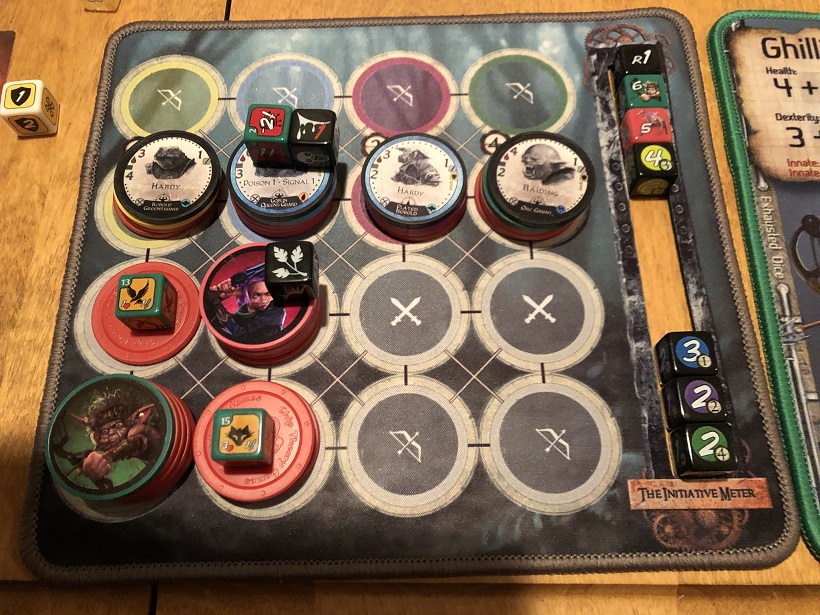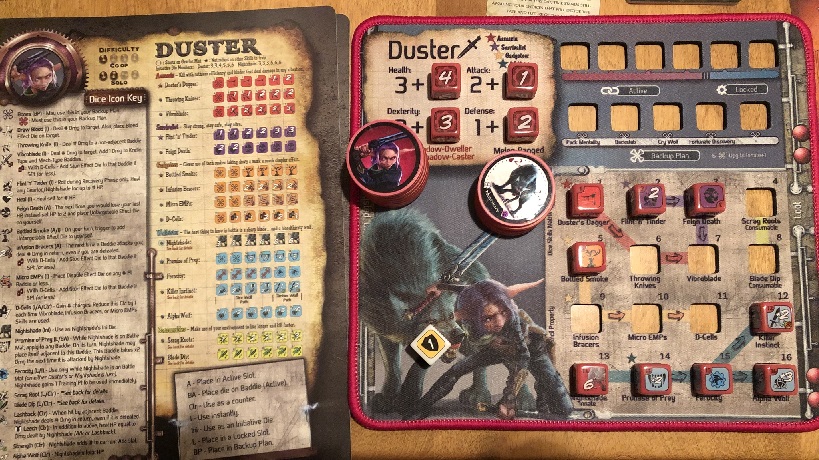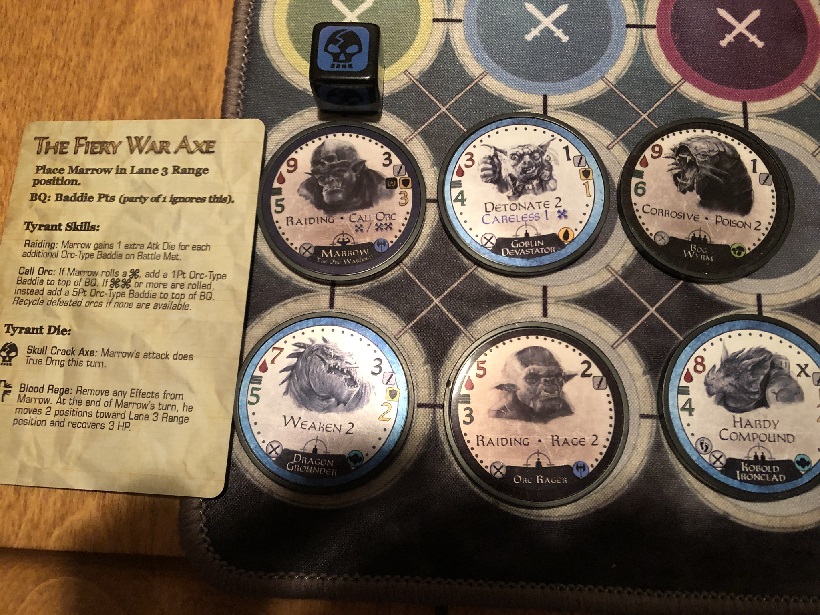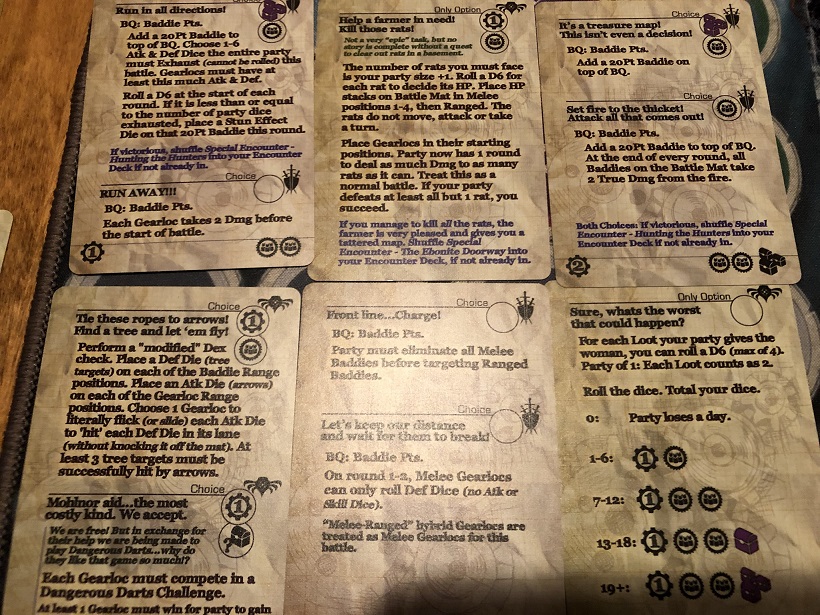So, today, I'm just gonna ramble about a specific board game I've been into. Why? Because I bloody well can, that's why. Nobody can stop me. Well, maybe Batman could.
Yeah, there's other hobbies I havent talked about yet, but they're a bit more difficult to do, so I'll hold off a bit till I've got photos and info sorted. For now... board games.
Today's game is Too Many Bones. Sometimes I wonder how they come up with these names.

Billed as a "dice-builder RPG", the game very clearly takes inspiration from the JRPG genre of video games. Heck, there's even an initiative meter there, to keep track of turn order! All the classic elements of JRPG combat are here, though this is dramatically more complicated, and far more difficult than any JRPG I've ever seen.
The most striking element though that anyone is going to notice right away is the components. This is AAA-level production quality here. Chip Theory Games, the creators of this wacky thing, seem to have the absolute highest quality of components in the industry as far as I know. Hilariously, the entire game is WATERPROOF. You could dump the whole thing in a filled bathtub, and all of it will be completely undamaged. Characters & enemies are represented by printed poker chips (those arent stickers on those!). The dice also do not use stickers for those colorful images on the side, so that's not coming off. The "boards"? High-end neoprene. Even the cards... the freaking CARDS... are waterproof, being made of some sort of funky plastic. The whole thing is nearly indestructible. I've seen all sorts of board games at this point, but nothing even comes close to matching the quality of the stuff these guys make.
But it also helps functionality. Dealing with all of those chips is soooooooo much better than using the usual cardboard tokens (which are often the most frustrating aspect of complicated games). For instance, in most games keeping track of the health points of characters or enemies will be done by covering them in little tokens. But here, you stack health chips (the blank red ones) underneath them, as shown in the photo there. It's easier, it's faster, it's less messy, and it's just darned satisfying to move those stacks around. The dice help here too, as not all dice are meant to be rolled. Some act as counters for instance, while others are "themed" dice. In the photo, the 3 dice near the top are all for showing status effects, the black ones in particular are usually not rolled, you simply set them to the appropriate side. Makes it super easy to keep track of stuff, faster to use, and easier to physically grasp.

But it's the gameplay that makes this so good.
Like in most RPGs, you've got all sorts of unique characters here, complete with stats and even skill trees. When you learn a new skill, stick the specific associated die in that slot. Improving stats, just rotate them. There is ALOT going on with these guys. Each comes with a big reference sheet, as seen on the left, showing what each individual symbol on each die does. Which is good, because every character has their own entirely unique set of 16 skill dice that do things. And they're wildly different.
I'm honestly stunned at just how creative they have gotten with these. For instance, Duster here has a giant wolf pal that can help her in combat. That wolf is built up seperately, using the blue section of the tree at the bottom there. See the two blue dice at the far right? A miniature skill tree specifically affecting the wolf's stats is on each one. Seriously. Also interesting is the "backup plan" mechanic. See those 5 slots above the skill tree? When you roll bones... or misses... on attack / defense / skill dice, you place them into that. The more you have, the more "backup" abilities you have access to (again, unique to each character), and you can spend them on your turn. If you manage to fill that meter, and get one more (hard to do, these dont carry over between encounters), you flip your character chip over, changing them to a boosted state for the rest of the playthrough. It's an incredible mechanic that takes the frustration out of getting "bad" rolls (usually). Also though, if you roll skill dice, but dont like the results, you have the option of putting them back without resolving them (with exceptions) though it still costs an action. There's alot of flexibility here. However, your character's dexterity stat determines how many actions you can take on a turn, with each movement or die roll taking up 1 point. Some other things also take up points, but that's going into character-specific complications.
And at the very top, active & locked slots are for holding certain skill dice after they've been rolled, either as a way to prep them for activation later, or to produce constant effects.
That's a heck of a lot going on with just ONE character, but the game's rules are very well written and easy to understand. However, you will be referring to those reference sheets *often*. I personally always play with 2 characters at once, and it works out quite well.

Of course, the bad guys have just as many tricks up their sleeves as you do. Here we see an example of some of them. The one in the upper left is one of the 7 bosses that comes with the base game, complete with his own special die that only he rolls, and a unique encounter, the card on the left. Beating the tyrant is the goal of your adventure.
All those other jerks work hard to stop you though. They're divided into different amounts of "baddie points". When you set up a battle, you have a certain number of points, based on how many days in you are, that will determine how many of each tier will show up. Baddies (yes, that's what the manual calls them) have a very wide array of wacky abilities, and there can be 4 on the map at any time, with more waiting in a queue sometimes. They can get super nasty. That one in the upper right is ranged, so it doesnt need to move to hit you, and can hit up to 3 targets at once, AND breaks your defense and causes poison. The Tyrants in particular are extra ridiculous.
If you want to have the foggiest chance of winning, you're going to really have to think out not just every individual move, but an overall strategy for the playthrough as a whole as you build up each character. And your decisions on how to power up can be affected by all sorts of different things, including items that you might get. But if the entire party is defeated in battle, you get nothing at all, yet still move onto the next day, and each is harder than the last. Beat the Tyrant before you run out of days to win. The game overall is stupidly difficult. Might be the hardest of all the ones I own so far.

It's not all combat though. And even when it is combat, there's usually different special rules or screwball conditions.
Each day presents a different encounter, which usually presents you with a choice of two possible options (with the other side of the card containing story text to define the situation, usually hilarious). Like everything else in the game, they've gotten super creative with these. Some encounters present you with minigames, even. There's one where you set up these 2 towers of red chips on a specific part of the battle mat, and then set this die on another specific spot, and you have 3 chances to flick the die with your finger, trying to get it to fly between the towers without touching them in order to win a big pile of loot. That's all just on ONE card. It's not something you have to pull from the rulebook. They do an incredible job of keeping things constantly fresh, so that any given playthrough never feels repetitive.
And naturally, the game has expansions too. Alot of them. I bought all of them.
I'd say the one downside the game has is that there's definitely a tough learning curve. The game comes with an absolutely silly number of dice (over 130!), and the majority of those are unique, containing symbols only found on that specific die. Combine that with the vast array of crazy enemy abilities, all sorts of different status effects, piles of loot (also loot BOXES. If you're into video games... yes, it's THOSE loot boxes. Seriously) and so on. And then combat just mashes all of this stuff together into this complicated dance of chaos as you struggle against whatever godawful situation it put you in. Interestingly though, for a game with 7 squillion dice, luck absolutely does not define your chances of victory. Sometimes it might seem that way... but that only means that you're not seeing tactical possibilities that are there. The game always gives you the tools to succeed, but it's up to you to figure out how to apply them.
Board games sure have come a long way from the brainless roll-to-move of games like Monopoly, eh?
And this one in particular is just amazing. While Aeon's End still remains my favorite, this one easily takes the #2 slot now. Just amazing. Expensive, but amazing. It's the one I keep telling friends about lately. Of course, that doesnt mean that they can afford to buy it. But hey, that's what Tabletop Simulator is for.
Yeah, there's other hobbies I havent talked about yet, but they're a bit more difficult to do, so I'll hold off a bit till I've got photos and info sorted. For now... board games.
Today's game is Too Many Bones. Sometimes I wonder how they come up with these names.

Billed as a "dice-builder RPG", the game very clearly takes inspiration from the JRPG genre of video games. Heck, there's even an initiative meter there, to keep track of turn order! All the classic elements of JRPG combat are here, though this is dramatically more complicated, and far more difficult than any JRPG I've ever seen.
The most striking element though that anyone is going to notice right away is the components. This is AAA-level production quality here. Chip Theory Games, the creators of this wacky thing, seem to have the absolute highest quality of components in the industry as far as I know. Hilariously, the entire game is WATERPROOF. You could dump the whole thing in a filled bathtub, and all of it will be completely undamaged. Characters & enemies are represented by printed poker chips (those arent stickers on those!). The dice also do not use stickers for those colorful images on the side, so that's not coming off. The "boards"? High-end neoprene. Even the cards... the freaking CARDS... are waterproof, being made of some sort of funky plastic. The whole thing is nearly indestructible. I've seen all sorts of board games at this point, but nothing even comes close to matching the quality of the stuff these guys make.
But it also helps functionality. Dealing with all of those chips is soooooooo much better than using the usual cardboard tokens (which are often the most frustrating aspect of complicated games). For instance, in most games keeping track of the health points of characters or enemies will be done by covering them in little tokens. But here, you stack health chips (the blank red ones) underneath them, as shown in the photo there. It's easier, it's faster, it's less messy, and it's just darned satisfying to move those stacks around. The dice help here too, as not all dice are meant to be rolled. Some act as counters for instance, while others are "themed" dice. In the photo, the 3 dice near the top are all for showing status effects, the black ones in particular are usually not rolled, you simply set them to the appropriate side. Makes it super easy to keep track of stuff, faster to use, and easier to physically grasp.

But it's the gameplay that makes this so good.
Like in most RPGs, you've got all sorts of unique characters here, complete with stats and even skill trees. When you learn a new skill, stick the specific associated die in that slot. Improving stats, just rotate them. There is ALOT going on with these guys. Each comes with a big reference sheet, as seen on the left, showing what each individual symbol on each die does. Which is good, because every character has their own entirely unique set of 16 skill dice that do things. And they're wildly different.
I'm honestly stunned at just how creative they have gotten with these. For instance, Duster here has a giant wolf pal that can help her in combat. That wolf is built up seperately, using the blue section of the tree at the bottom there. See the two blue dice at the far right? A miniature skill tree specifically affecting the wolf's stats is on each one. Seriously. Also interesting is the "backup plan" mechanic. See those 5 slots above the skill tree? When you roll bones... or misses... on attack / defense / skill dice, you place them into that. The more you have, the more "backup" abilities you have access to (again, unique to each character), and you can spend them on your turn. If you manage to fill that meter, and get one more (hard to do, these dont carry over between encounters), you flip your character chip over, changing them to a boosted state for the rest of the playthrough. It's an incredible mechanic that takes the frustration out of getting "bad" rolls (usually). Also though, if you roll skill dice, but dont like the results, you have the option of putting them back without resolving them (with exceptions) though it still costs an action. There's alot of flexibility here. However, your character's dexterity stat determines how many actions you can take on a turn, with each movement or die roll taking up 1 point. Some other things also take up points, but that's going into character-specific complications.
And at the very top, active & locked slots are for holding certain skill dice after they've been rolled, either as a way to prep them for activation later, or to produce constant effects.
That's a heck of a lot going on with just ONE character, but the game's rules are very well written and easy to understand. However, you will be referring to those reference sheets *often*. I personally always play with 2 characters at once, and it works out quite well.

Of course, the bad guys have just as many tricks up their sleeves as you do. Here we see an example of some of them. The one in the upper left is one of the 7 bosses that comes with the base game, complete with his own special die that only he rolls, and a unique encounter, the card on the left. Beating the tyrant is the goal of your adventure.
All those other jerks work hard to stop you though. They're divided into different amounts of "baddie points". When you set up a battle, you have a certain number of points, based on how many days in you are, that will determine how many of each tier will show up. Baddies (yes, that's what the manual calls them) have a very wide array of wacky abilities, and there can be 4 on the map at any time, with more waiting in a queue sometimes. They can get super nasty. That one in the upper right is ranged, so it doesnt need to move to hit you, and can hit up to 3 targets at once, AND breaks your defense and causes poison. The Tyrants in particular are extra ridiculous.
If you want to have the foggiest chance of winning, you're going to really have to think out not just every individual move, but an overall strategy for the playthrough as a whole as you build up each character. And your decisions on how to power up can be affected by all sorts of different things, including items that you might get. But if the entire party is defeated in battle, you get nothing at all, yet still move onto the next day, and each is harder than the last. Beat the Tyrant before you run out of days to win. The game overall is stupidly difficult. Might be the hardest of all the ones I own so far.

It's not all combat though. And even when it is combat, there's usually different special rules or screwball conditions.
Each day presents a different encounter, which usually presents you with a choice of two possible options (with the other side of the card containing story text to define the situation, usually hilarious). Like everything else in the game, they've gotten super creative with these. Some encounters present you with minigames, even. There's one where you set up these 2 towers of red chips on a specific part of the battle mat, and then set this die on another specific spot, and you have 3 chances to flick the die with your finger, trying to get it to fly between the towers without touching them in order to win a big pile of loot. That's all just on ONE card. It's not something you have to pull from the rulebook. They do an incredible job of keeping things constantly fresh, so that any given playthrough never feels repetitive.
And naturally, the game has expansions too. Alot of them. I bought all of them.
I'd say the one downside the game has is that there's definitely a tough learning curve. The game comes with an absolutely silly number of dice (over 130!), and the majority of those are unique, containing symbols only found on that specific die. Combine that with the vast array of crazy enemy abilities, all sorts of different status effects, piles of loot (also loot BOXES. If you're into video games... yes, it's THOSE loot boxes. Seriously) and so on. And then combat just mashes all of this stuff together into this complicated dance of chaos as you struggle against whatever godawful situation it put you in. Interestingly though, for a game with 7 squillion dice, luck absolutely does not define your chances of victory. Sometimes it might seem that way... but that only means that you're not seeing tactical possibilities that are there. The game always gives you the tools to succeed, but it's up to you to figure out how to apply them.
Board games sure have come a long way from the brainless roll-to-move of games like Monopoly, eh?
And this one in particular is just amazing. While Aeon's End still remains my favorite, this one easily takes the #2 slot now. Just amazing. Expensive, but amazing. It's the one I keep telling friends about lately. Of course, that doesnt mean that they can afford to buy it. But hey, that's what Tabletop Simulator is for.
